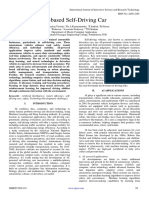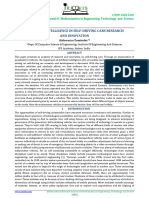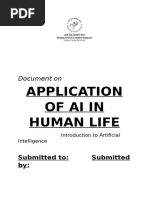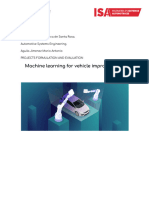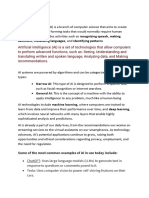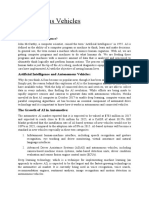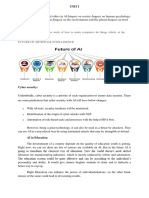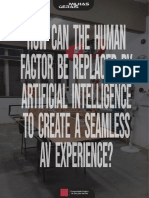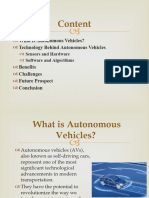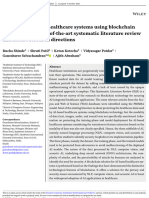Ai in Road Safety
Ai in Road Safety
Uploaded by
krutikathakare60Copyright:
Available Formats
Ai in Road Safety
Ai in Road Safety
Uploaded by
krutikathakare60Copyright
Available Formats
Share this document
Did you find this document useful?
Is this content inappropriate?
Copyright:
Available Formats
Ai in Road Safety
Ai in Road Safety
Uploaded by
krutikathakare60Copyright:
Available Formats
ARTIFICIAL INTELLIGENCE IN ROAD SAFETY
INTRODUCTION
What is AI?
Artificial intelligence (AI) is the theory and development of computer systems
capable of performing tasks that historically required human intelligence, such
as recognizing speech, making decisions, and identifying patterns. AI is an
umbrella term that encompasses a wide variety of technologies,
including machine learning, deep learning, and natural language processing
(NLP). Although the term is commonly used to describe a range of different
technologies in use today, many disagree on whether these actually constitute
artificial intelligence. Instead, some argue that much of the technology used in
the real world today actually constitutes highly advanced machine learning that
is simply a first step towards true artificial intelligence, or “general artificial
intelligence”.
Important’s of AI in today’s world:
Transforming every walk of life. Enabling rethinking of information integration
and data analysis. Revolutionizing processes, improving outcomes, and driving
innovation. Mimicking human intelligence and performing tasks traditionally
requiring human involvement. Altering lifestyles, work dynamics, and daily
activities . Revolutionizing industries such as healthcare, finance, and education
Improving efficiency, reducing costs, and increasing accuracy in various fields.
Artificial Intelligence has the potential to transform various fields and
revolutionize several industries, including healthcare, transportation, finance,
education, marketing and entertainment. Artificial Intelligence (AI) has evolved
rapidly, becoming a transformative technology in many areas of modern life. At
its core, AI involves the development of computer systems capable of
performing tasks that traditionally require human intelligence, such as visual
perception, speech recognition, decision-making, and language translation.
The significance of AI in computer science lies in its ability to pave the way for
groundbreaking applications and new technologies that were once deemed
impossible.
Significanes of AI in road safety
As we step into 2024, the role of artificial intelligence (AI) in road safety has
become increasingly crucial. From predictive analytics to autonomous vehicles,
AI is transforming the way we ensure safety on our roads. In this article, we'll
explore how AI is being used to enhance road safety, the technologies involved,
and the future prospects of this revolutionary field. AI in road safety isn't just
about self-driving cars; it encompasses a wide range of technologies aimed at
reducing accidents and enhancing overall safety. Whether it's through real-time
traffic monitoring, predictive maintenance, or advanced driver-assistance
systems (ADAS), AI is playing a pivotal role in making our roads safer. One of the
most significant applications of AI in road safety is predictive analytics. By
analyzing vast amounts of data from traffic cameras, sensors, and historical
data, AI can predict traffic patterns, identify congestion hotspots, and even
forecast potential accidents. This information is invaluable for traffic
management authorities, allowing them to make data-driven decisions to
improve traffic flow and reduce the risk of accidents. AI is also being used to
maintain and improve road infrastructure. By analyzing data from sensors and
cameras, AI can identify issues such as potholes, damaged signs, and other
hazards before they become a safety risk. This allows for proactive
maintenance, ensuring that roads are kept in good condition and reducing the
risk of accidents caused by poor infrastructure.
LITERATURE
There’s a growing body of literature on the application of AI in road safety,
focusing on various aspects such as accident prediction, traffic management,
and vehicle automation. Here are some key areas of research and examples:
1. Accident Prediction and Analysis:
o Studies utilize machine learning algorithms to analyze historical
accident data, identifying patterns and predicting future incidents.
Techniques like regression analysis and neural networks are
common.
2. Traffic Management Systems:
o AI systems optimize traffic flow and reduce congestion. Research
often highlights adaptive traffic signal control and the use of real-
time data from sensors and cameras to improve traffic conditions.
3. Autonomous Vehicles:
o Literature explores how AI in autonomous vehicles can enhance
safety through advanced perception systems, decision-making
algorithms, and vehicle-to-vehicle (V2V) communication.
4. Driver Behavior Monitoring:
o AI technologies, such as computer vision and wearable devices,
analyze driver behavior to identify distractions or fatigue, aiming
to prevent accidents before they occur.
5. Predictive Analytics for Infrastructure Maintenance:
o Studies focus on using AI to predict when road infrastructure
needs maintenance, helping to prevent accidents caused by poor
road conditions.
6. Smart City Initiatives:
o Research highlights the integration of AI into smart city
frameworks, focusing on how interconnected systems can improve
overall road safety through data sharing and real-time responses.
METHODOLOGY
You might also like
- 01 AI OverviewDocument62 pages01 AI OverviewDhouha BenzinaNo ratings yet
- Ensuring Road Safety Using Its ServiceDocument5 pagesEnsuring Road Safety Using Its ServiceMayank SainiNo ratings yet
- AI-based Self-Driving CarDocument9 pagesAI-based Self-Driving CarInternational Journal of Innovative Science and Research TechnologyNo ratings yet
- 5 Benefits of AI in Transportation Sector_ Key InsightsDocument2 pages5 Benefits of AI in Transportation Sector_ Key Insightsjana.antounNo ratings yet
- Self Driving Cars Article #02Document10 pagesSelf Driving Cars Article #02demithehomieNo ratings yet
- Preventing Accidents With AI a Comprehensive ApproachDocument10 pagesPreventing Accidents With AI a Comprehensive Approachporshexhem18No ratings yet
- fin_irjmets1647283669Document8 pagesfin_irjmets1647283669prasanth palanimuthuNo ratings yet
- The Use of Artificial IntelligenceDocument5 pagesThe Use of Artificial Intelligencedaboweg325No ratings yet
- Document 16Document3 pagesDocument 16almazanandrew2No ratings yet
- Report 4 (Engr400)Document2 pagesReport 4 (Engr400)Vijay ReddyNo ratings yet
- AI in Autonomous Vehicles: A Comprehensive Study of Perception, Decision-Making, Path Planning, and Safety ConsiderationsDocument29 pagesAI in Autonomous Vehicles: A Comprehensive Study of Perception, Decision-Making, Path Planning, and Safety ConsiderationsInternational Journal of Innovative Science and Research TechnologyNo ratings yet
- Lesson 2Document2 pagesLesson 2y4b3seNo ratings yet
- The Rise of Artificial Intelligence Transforming Industries and Shaping The FutureDocument8 pagesThe Rise of Artificial Intelligence Transforming Industries and Shaping The Futureabalengmathobisa01No ratings yet
- AI in Transportation IndustryDocument12 pagesAI in Transportation Industrymde242m003No ratings yet
- Document OnDocument15 pagesDocument OnShweta RanjanaNo ratings yet
- Embrace Integrated AI PowerhousesDocument9 pagesEmbrace Integrated AI PowerhousesDr MahaNo ratings yet
- AI,ML,DL usages in AUTOMOTIVE INDUSTRY realDocument43 pagesAI,ML,DL usages in AUTOMOTIVE INDUSTRY realvrva0809No ratings yet
- Artificial Intelligence Traffic PredictionDocument11 pagesArtificial Intelligence Traffic Predictionmounikarayalla1No ratings yet
- Artificial IntelligenceDocument4 pagesArtificial Intelligencemiyaganesh5No ratings yet
- Aguila JImenez Mario ProjectoDocument18 pagesAguila JImenez Mario ProjectoMARIO ANTONIO AGUILA JIMENEZNo ratings yet
- EAI Notes 1Document15 pagesEAI Notes 1Anonymous 96No ratings yet
- FinalDocument37 pagesFinalsakthisakthi4112002No ratings yet
- Traffic Management System Using AI 1Document9 pagesTraffic Management System Using AI 1saraswathireddy2727No ratings yet
- The Crucial Role of Artificial Intelligence in Enhancing Safety, and Reducing Congestion in Traffic SystemDocument9 pagesThe Crucial Role of Artificial Intelligence in Enhancing Safety, and Reducing Congestion in Traffic SystemMuizz AsifNo ratings yet
- The Role of Artificial Intelligence in Car Safety SystemsDocument5 pagesThe Role of Artificial Intelligence in Car Safety Systemsbrian.kweonaecomNo ratings yet
- Artificial Intelligence in The Automotive IndustryDocument12 pagesArtificial Intelligence in The Automotive Industryaddo negnNo ratings yet
- HenimikaymhundgutDocument2 pagesHenimikaymhundgutheni16belayNo ratings yet
- AI Document (1) (1)Document23 pagesAI Document (1) (1)2408022.samridhiNo ratings yet
- SeminarDocument31 pagesSeminarifizon williamNo ratings yet
- 7.ai in Finance 8.ai in Finance: Ai and It'S FunctionDocument25 pages7.ai in Finance 8.ai in Finance: Ai and It'S Functiondeathlord274No ratings yet
- Application of Disruptive Technologies in Business: Ai in Automobile IndustryDocument20 pagesApplication of Disruptive Technologies in Business: Ai in Automobile IndustryNaimish RastogiNo ratings yet
- AI Use in Diffrent Sectors - Research PaperDocument7 pagesAI Use in Diffrent Sectors - Research PaperShorya AgrawalNo ratings yet
- AI InformationDocument8 pagesAI InformationAtharv PotdarNo ratings yet
- Course Project:Emerging Technologies in Road SafetyDocument3 pagesCourse Project:Emerging Technologies in Road SafetyDr. MAHABOOB PEERA KNo ratings yet
- Unit5-Applications of Artificial IntelligenceDocument18 pagesUnit5-Applications of Artificial Intelligencemrai48851No ratings yet
- Autonomous Vehicles: Challenges and Advancements in AI-Based Navigation SystemsDocument12 pagesAutonomous Vehicles: Challenges and Advancements in AI-Based Navigation SystemsInternational Journal of Innovative Science and Research TechnologyNo ratings yet
- civel pdfDocument16 pagescivel pdfKumar SeenigouderNo ratings yet
- Describe AI: Decisions, Translating Languages, and Identifying PatternsDocument8 pagesDescribe AI: Decisions, Translating Languages, and Identifying Patternswevem43603No ratings yet
- Artificial Intelligence and Autonomous VehiclesDocument6 pagesArtificial Intelligence and Autonomous VehiclesDurga KNo ratings yet
- AI for smart mobility article IEEEDocument11 pagesAI for smart mobility article IEEEmendel nanfackNo ratings yet
- Criteria For A Futuristic Smart CarDocument3 pagesCriteria For A Futuristic Smart CarAhmad MaNo ratings yet
- CoverpageDocument2 pagesCoverpageheni16belayNo ratings yet
- BCE Technical Paper writtenDocument5 pagesBCE Technical Paper writtenmohammedtauqeer4octNo ratings yet
- CCS345-Unit IDocument10 pagesCCS345-Unit IKathir VNo ratings yet
- Autonomous Vehicles-How AI Is Revolutionizing TransportationDocument14 pagesAutonomous Vehicles-How AI Is Revolutionizing Transportationmziaudin44No ratings yet
- AI TPDocument6 pagesAI TPmoisekimsNo ratings yet
- Untitled DocumentDocument2 pagesUntitled DocumentJuan BrattiNo ratings yet
- Pitch The Future 2022 - Team Milhas GeraisDocument8 pagesPitch The Future 2022 - Team Milhas GeraisAfonso Emmanuel Sclafani PujattiNo ratings yet
- CarsDocument2 pagesCarsyovego4917No ratings yet
- How Artificial Intelligence is Transforming the WorldDocument28 pagesHow Artificial Intelligence is Transforming the Worlddimamor20021230No ratings yet
- The Rise of Artificial IntelligenceDocument2 pagesThe Rise of Artificial IntelligenceJonathan BasilioNo ratings yet
- Ai in CarsDocument3 pagesAi in Carsmrathod2003No ratings yet
- Tabasum Burfat ICTDocument3 pagesTabasum Burfat ICTtabasumburfatNo ratings yet
- The Transformative Power of Artificial IntelligenceDocument2 pagesThe Transformative Power of Artificial Intelligence2gc8g13ouNo ratings yet
- Why Is Artificial IntelligenceDocument2 pagesWhy Is Artificial IntelligenceTonya BraynenNo ratings yet
- 5 Autonomous VehiclesDocument13 pages5 Autonomous Vehiclesanamayank111No ratings yet
- DR +Amit+BhardwajDocument7 pagesDR +Amit+Bhardwaj4dham.xiNo ratings yet
- Transformative Power of AIDocument2 pagesTransformative Power of AIRAHUL CHANDANNo ratings yet
- CH 0 H TS7 NyyDocument4 pagesCH 0 H TS7 NyyBlue BlusterNo ratings yet
- Case StudyDocument11 pagesCase Studyaman.khan24No ratings yet
- Final Edit 2Document19 pagesFinal Edit 2Yash AwasthiNo ratings yet
- SMS Spam Detection Using Machine LearningDocument68 pagesSMS Spam Detection Using Machine LearningBhojraj BalajeeNo ratings yet
- Delhi Public School Bangalore NorthDocument9 pagesDelhi Public School Bangalore NorthDinakaar SNo ratings yet
- On The Opportunities and Risks of Foundation Models: Corresponding Author: Pliang@cs - Stanford.edu Equal ContributionDocument211 pagesOn The Opportunities and Risks of Foundation Models: Corresponding Author: Pliang@cs - Stanford.edu Equal ContributionasdljknNo ratings yet
- NLP Assignment AnswerDocument4 pagesNLP Assignment AnswerAliffNo ratings yet
- Automatic Error Detection and Correction in MalayalamDocument5 pagesAutomatic Error Detection and Correction in MalayalamIJSTE100% (1)
- BussinDocument81 pagesBussinAksauce SuccedNo ratings yet
- RLDL FileDocument31 pagesRLDL Fileanshugarg401No ratings yet
- Shruti Mishra Resume 1561126094Document1 pageShruti Mishra Resume 1561126094Arjit ChauhanNo ratings yet
- AI in China 2020 White Paper by Daxue Consulting 2Document140 pagesAI in China 2020 White Paper by Daxue Consulting 2tfhrddh100% (1)
- The Ai Whisperer B0D1YR1ZP3Document239 pagesThe Ai Whisperer B0D1YR1ZP365011146No ratings yet
- Ai Elsevier MethodologyDocument7 pagesAi Elsevier Methodologycifaboc378No ratings yet
- Lec#1 PDFDocument36 pagesLec#1 PDFMeer Zafarullah NoohaniNo ratings yet
- Embeddings in Natural Language Processing Theory and Advances in Vector Representations of Meaning 1st Edition Mohammad Taher Pilehvar 2024 Scribd DownloadDocument55 pagesEmbeddings in Natural Language Processing Theory and Advances in Vector Representations of Meaning 1st Edition Mohammad Taher Pilehvar 2024 Scribd Downloadrigelsnalci100% (5)
- The Usage of Bots in Open Source Software DevelopmentDocument4 pagesThe Usage of Bots in Open Source Software DevelopmentPranav PawarNo ratings yet
- Rtu-I & Ii (Mercy Back) and Iv & Vi (Back) Sem Exam Schedule, June-July-2023Document18 pagesRtu-I & Ii (Mercy Back) and Iv & Vi (Back) Sem Exam Schedule, June-July-2023mitushiNo ratings yet
- Online Paper Submission - 8th International Conference on Natural Language Processing and Trends (NATAP 2025)Document2 pagesOnline Paper Submission - 8th International Conference on Natural Language Processing and Trends (NATAP 2025)International Journal on Web Service Computing (IJWSC)No ratings yet
- Black-Box Analysis: Gpts Across Time in Legal Textual Entailment TaskDocument6 pagesBlack-Box Analysis: Gpts Across Time in Legal Textual Entailment Tasklearn our ReligionNo ratings yet
- ChatGPT For Business ProfessionalsDocument7 pagesChatGPT For Business ProfessionalsMurtazaNo ratings yet
- NLP Quesion BankDocument4 pagesNLP Quesion Bankmasumamemories12No ratings yet
- Design of Healthbot Using AI For Medical AssistanceDocument7 pagesDesign of Healthbot Using AI For Medical Assistancenikhilxd13No ratings yet
- INTRODUCTIONDocument18 pagesINTRODUCTIONHimanshu SinghNo ratings yet
- Learning To Reason For Text Generation From Scientific TablesDocument12 pagesLearning To Reason For Text Generation From Scientific TablesFernando AllendeNo ratings yet
- AMT302 QUESTION BANK - FormatDocument3 pagesAMT302 QUESTION BANK - FormatJoshua DavidNo ratings yet
- AI complete notesDocument32 pagesAI complete notesrupasandhyamNo ratings yet
- NLP NotesDocument16 pagesNLP Notesprakarshkhandelwal18No ratings yet
- LocalGLMnet: A Deep Learning Architecture For ActuariesDocument35 pagesLocalGLMnet: A Deep Learning Architecture For Actuariespapatest123No ratings yet
- Introduction To AiDocument12 pagesIntroduction To Aivanshika rajNo ratings yet
- Transactions On Emerging Telecommunications Technologies - 2023 - Shinde - Securing AI Based Healthcare Systems UsingDocument48 pagesTransactions On Emerging Telecommunications Technologies - 2023 - Shinde - Securing AI Based Healthcare Systems UsingFerucio TipleaNo ratings yet


